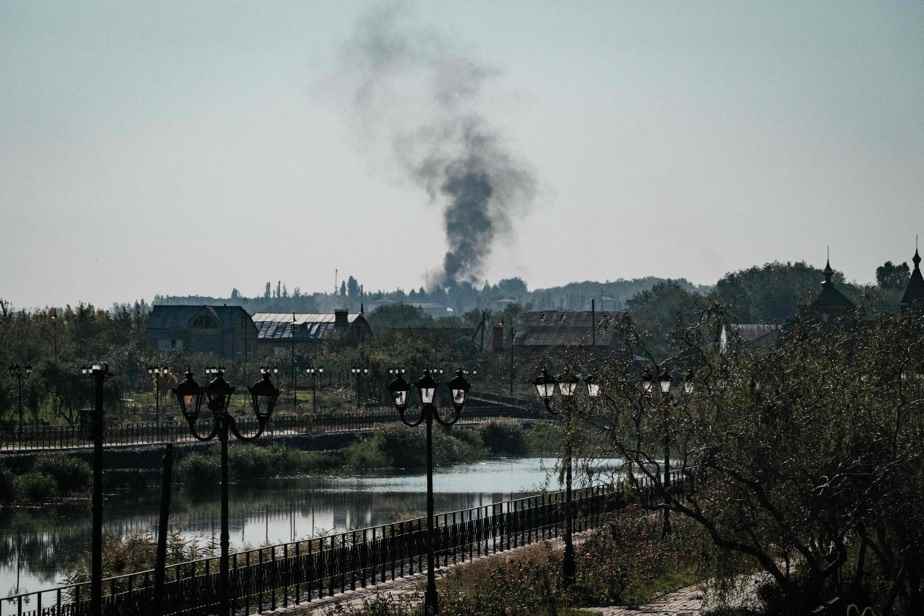(Bakhmout) During the day, a ritual rain of shells, and at night, an increasingly close face-to-face that drove some soldiers mad. On the eastern front of Ukraine, Bakhmout is one of the last towns where Russian forces, elsewhere in retreat, are still advancing.
Posted at 10:04 a.m.
The small town (70,000 inhabitants before the war) reverberates from all the surrounding hills, the regular sound of shells, incoming and outgoing strikes.
While everywhere the Russian army is retreating, Bakhmout has become, according to Ukrainian President Zelensky, the “most difficult” point for the Ukrainian forces, which remain in this sector in a defensive position.
Ukrainian soldiers still control the western and northern half of the city, AFP journalists noted on Saturday.
In the center, a demarcation line, marked by iron braces and concrete blocks, was erected. From there, it’s the “zero point”, the Ukrainian front line and no one passes.
Behind, in the rest of the agglomeration and at its exit, it is the “grey zone”, where the Russian fighters or their supporters lead the offensive.
Separatist forces in the Donetsk region, backed by Russia and maneuvering in this battle, surged east and south, taking advantage of the proximity of their rear base to the city of Donetsk 100 km away.
On Thursday, they announced that they had taken the two neighboring suburbs, Opytin and Ivangrad.
6 p.m.: first commandos
Since then, fears of an infiltration of Russian forces in the eastern part of the city, including mercenaries from the paramilitary group Wagner, according to a note from British intelligence, have been reinforced.
And the battle, according to Ukrainian fighters interviewed by AFP, turned face-to-face with these auxiliary militias.
“They (the enemy troops) start when it’s dark, around 6 p.m. they send the first reconnaissance commandos,” explains Anton, known as “Poliak”, a 50-year-old Ukrainian soldier from the 93e brigade, back from the front after a minor injury and a state of exhaustion.
But these soldiers, whom he bitterly calls “single use”, are recruits without experience, he assures us, “that they send under our bullets” to “create a diversion”, while the Russian sabotage commandos , described as more experienced, maneuver farther.
“By 5 a.m., we have seven or eight (diversionary) attacks like these,” he explains.
After four nights and four days without sleep, “Poliak”, a truck driver in his previous life, recognizes with tension and fatigue that he had “hallucinations”.
One night, his unit opened fire, believing they detected a Russian commando in the night vision scope. In the early morning, they understood that they had fired at wooden logs. Since then, the group left in the trench with 13 men, and returned to 11, including 5 wounded, has been put to rest.
“I wander”
In the center still under Ukrainian control, after two months of active fighting, each building, when it is still standing, bears a stigma: broken windows, a roof torn off by an explosion.
The civilians live in their cellars, defying the bombings to get something to eat, drink, keep warm, charge a telephone on a collective generator or get some fresh air for a few minutes.
In Bakhmout, there is no more water or gas and the electricity was cut ten days ago for good. The telephone network, miraculously, still holds. A market, with a few foodstuffs arranged on wooden boards, also allows you to stock up.
An 80-year-old woman, holding a pipe to tinker with her wood-burning stove, stands in the street in shock.
“We can’t even bury people anymore!” “, she laments.
“My sister has been under the debris (after a strike) since the night of October 12-13. No one can come and pick it up. I wander. I don’t know where to go”, explains this former beekeeper.
“My bees are somewhere in the forest, on their own. We, too, left to our own devices,” she concludes, bursting into tears.
